Report on Human Resources Management Challenges and Strategies
VerifiedAdded on 2020/02/18
|10
|1951
|46
Report
AI Summary
This report delves into the intricacies of human resources management (HRM) within complex business environments. It begins by outlining the significance of HRM strategies, including employee hiring and selection processes, and the critical role of a dedicated HRM department. The report then identifies several challenges faced by organizations, such as communication issues, diverse employee needs, and the impact of organizational culture and technology on employee motivation and turnover. Furthermore, the report highlights multigenerational workforce problems, talent attrition and retention, and the complexities of managing benefits and perks programs. The conclusion emphasizes the importance of aligning HRM policies with employee welfare and organizational development to foster a positive and productive work environment. The report draws on various sources to support its findings and recommendations.
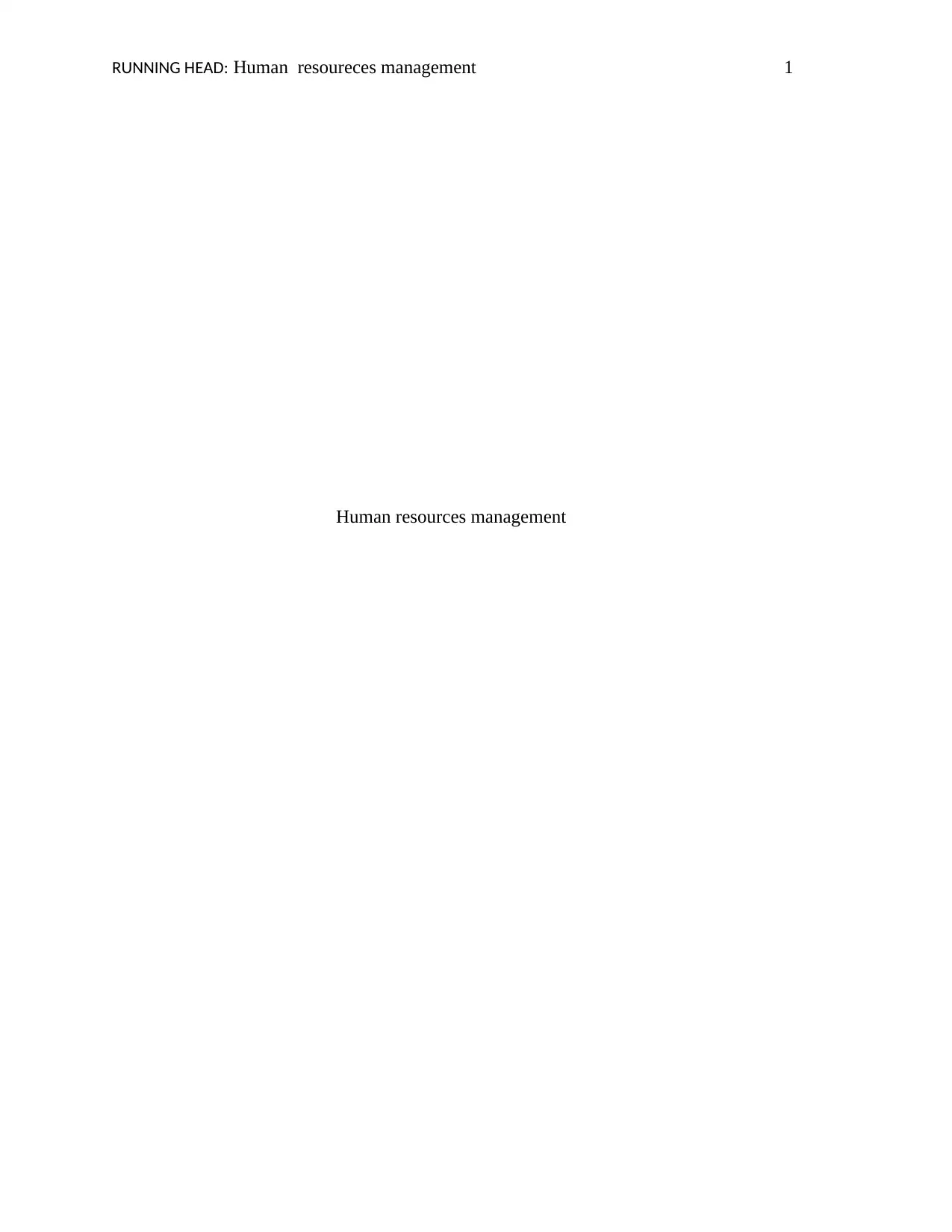
RUNNING HEAD: Human resoureces management 1
Human resources management
Human resources management
Paraphrase This Document
Need a fresh take? Get an instant paraphrase of this document with our AI Paraphraser
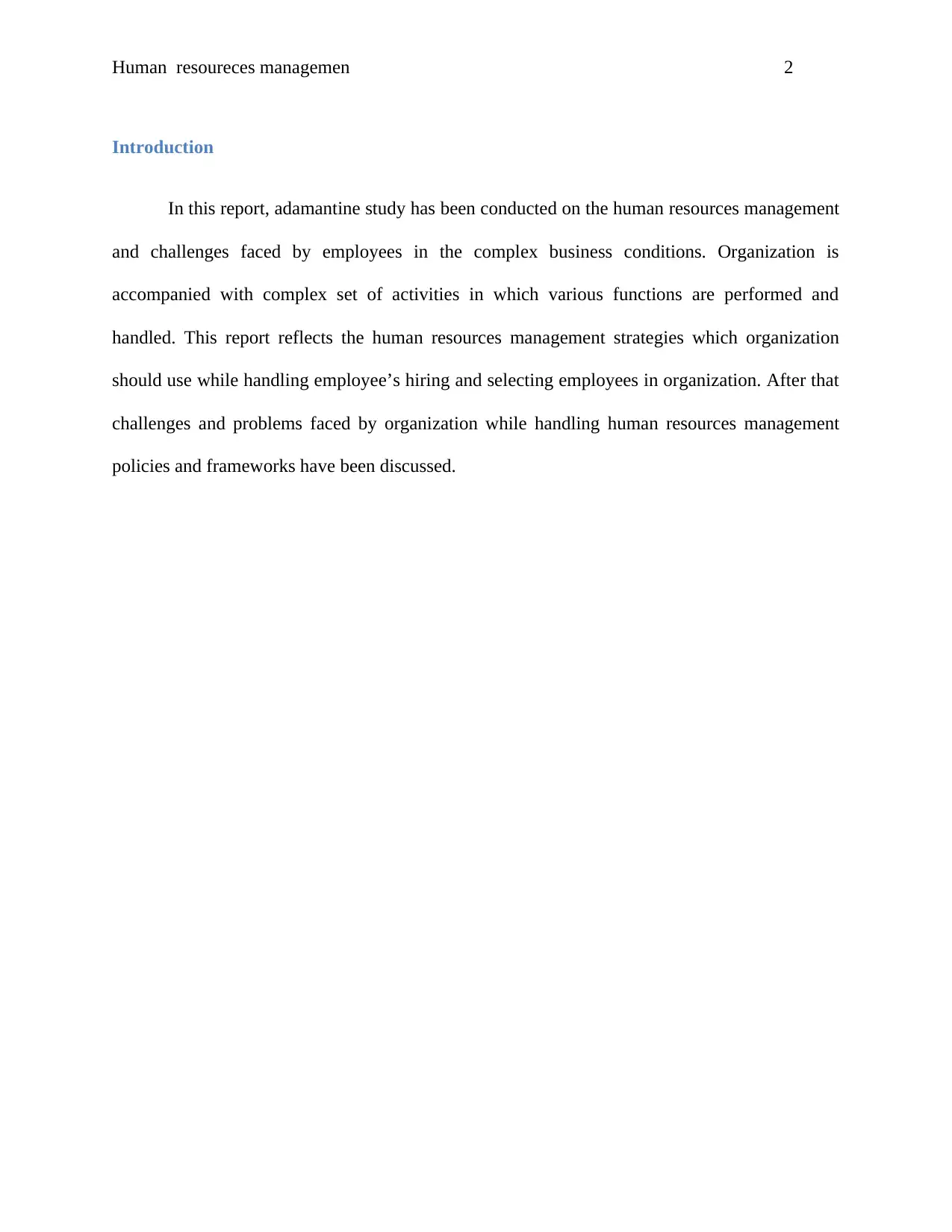
Human resoureces managemen 2
Introduction
In this report, adamantine study has been conducted on the human resources management
and challenges faced by employees in the complex business conditions. Organization is
accompanied with complex set of activities in which various functions are performed and
handled. This report reflects the human resources management strategies which organization
should use while handling employee’s hiring and selecting employees in organization. After that
challenges and problems faced by organization while handling human resources management
policies and frameworks have been discussed.
Introduction
In this report, adamantine study has been conducted on the human resources management
and challenges faced by employees in the complex business conditions. Organization is
accompanied with complex set of activities in which various functions are performed and
handled. This report reflects the human resources management strategies which organization
should use while handling employee’s hiring and selecting employees in organization. After that
challenges and problems faced by organization while handling human resources management
policies and frameworks have been discussed.
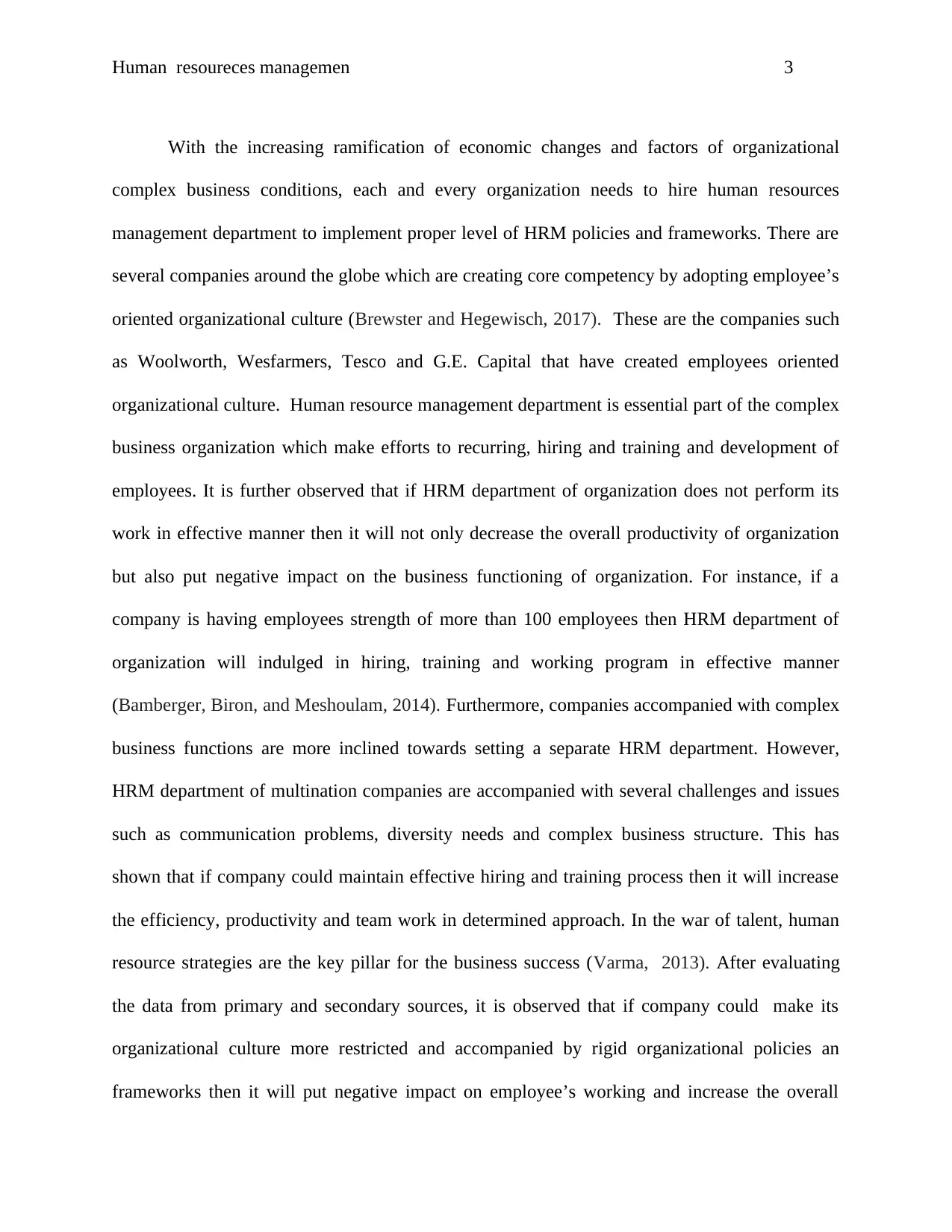
Human resoureces managemen 3
With the increasing ramification of economic changes and factors of organizational
complex business conditions, each and every organization needs to hire human resources
management department to implement proper level of HRM policies and frameworks. There are
several companies around the globe which are creating core competency by adopting employee’s
oriented organizational culture (Brewster and Hegewisch, 2017). These are the companies such
as Woolworth, Wesfarmers, Tesco and G.E. Capital that have created employees oriented
organizational culture. Human resource management department is essential part of the complex
business organization which make efforts to recurring, hiring and training and development of
employees. It is further observed that if HRM department of organization does not perform its
work in effective manner then it will not only decrease the overall productivity of organization
but also put negative impact on the business functioning of organization. For instance, if a
company is having employees strength of more than 100 employees then HRM department of
organization will indulged in hiring, training and working program in effective manner
(Bamberger, Biron, and Meshoulam, 2014). Furthermore, companies accompanied with complex
business functions are more inclined towards setting a separate HRM department. However,
HRM department of multination companies are accompanied with several challenges and issues
such as communication problems, diversity needs and complex business structure. This has
shown that if company could maintain effective hiring and training process then it will increase
the efficiency, productivity and team work in determined approach. In the war of talent, human
resource strategies are the key pillar for the business success (Varma, 2013). After evaluating
the data from primary and secondary sources, it is observed that if company could make its
organizational culture more restricted and accompanied by rigid organizational policies an
frameworks then it will put negative impact on employee’s working and increase the overall
With the increasing ramification of economic changes and factors of organizational
complex business conditions, each and every organization needs to hire human resources
management department to implement proper level of HRM policies and frameworks. There are
several companies around the globe which are creating core competency by adopting employee’s
oriented organizational culture (Brewster and Hegewisch, 2017). These are the companies such
as Woolworth, Wesfarmers, Tesco and G.E. Capital that have created employees oriented
organizational culture. Human resource management department is essential part of the complex
business organization which make efforts to recurring, hiring and training and development of
employees. It is further observed that if HRM department of organization does not perform its
work in effective manner then it will not only decrease the overall productivity of organization
but also put negative impact on the business functioning of organization. For instance, if a
company is having employees strength of more than 100 employees then HRM department of
organization will indulged in hiring, training and working program in effective manner
(Bamberger, Biron, and Meshoulam, 2014). Furthermore, companies accompanied with complex
business functions are more inclined towards setting a separate HRM department. However,
HRM department of multination companies are accompanied with several challenges and issues
such as communication problems, diversity needs and complex business structure. This has
shown that if company could maintain effective hiring and training process then it will increase
the efficiency, productivity and team work in determined approach. In the war of talent, human
resource strategies are the key pillar for the business success (Varma, 2013). After evaluating
the data from primary and secondary sources, it is observed that if company could make its
organizational culture more restricted and accompanied by rigid organizational policies an
frameworks then it will put negative impact on employee’s working and increase the overall
⊘ This is a preview!⊘
Do you want full access?
Subscribe today to unlock all pages.

Trusted by 1+ million students worldwide
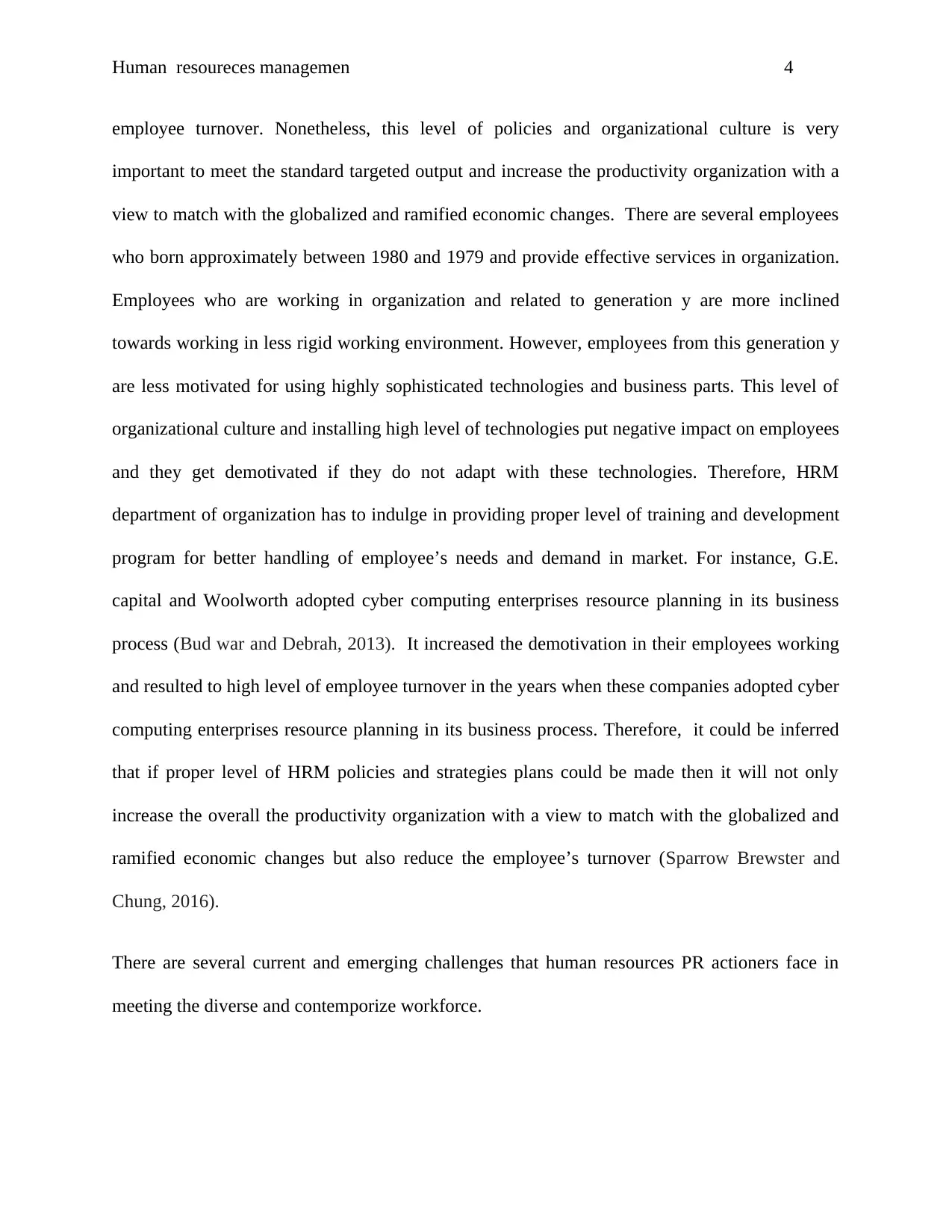
Human resoureces managemen 4
employee turnover. Nonetheless, this level of policies and organizational culture is very
important to meet the standard targeted output and increase the productivity organization with a
view to match with the globalized and ramified economic changes. There are several employees
who born approximately between 1980 and 1979 and provide effective services in organization.
Employees who are working in organization and related to generation y are more inclined
towards working in less rigid working environment. However, employees from this generation y
are less motivated for using highly sophisticated technologies and business parts. This level of
organizational culture and installing high level of technologies put negative impact on employees
and they get demotivated if they do not adapt with these technologies. Therefore, HRM
department of organization has to indulge in providing proper level of training and development
program for better handling of employee’s needs and demand in market. For instance, G.E.
capital and Woolworth adopted cyber computing enterprises resource planning in its business
process (Bud war and Debrah, 2013). It increased the demotivation in their employees working
and resulted to high level of employee turnover in the years when these companies adopted cyber
computing enterprises resource planning in its business process. Therefore, it could be inferred
that if proper level of HRM policies and strategies plans could be made then it will not only
increase the overall the productivity organization with a view to match with the globalized and
ramified economic changes but also reduce the employee’s turnover (Sparrow Brewster and
Chung, 2016).
There are several current and emerging challenges that human resources PR actioners face in
meeting the diverse and contemporize workforce.
employee turnover. Nonetheless, this level of policies and organizational culture is very
important to meet the standard targeted output and increase the productivity organization with a
view to match with the globalized and ramified economic changes. There are several employees
who born approximately between 1980 and 1979 and provide effective services in organization.
Employees who are working in organization and related to generation y are more inclined
towards working in less rigid working environment. However, employees from this generation y
are less motivated for using highly sophisticated technologies and business parts. This level of
organizational culture and installing high level of technologies put negative impact on employees
and they get demotivated if they do not adapt with these technologies. Therefore, HRM
department of organization has to indulge in providing proper level of training and development
program for better handling of employee’s needs and demand in market. For instance, G.E.
capital and Woolworth adopted cyber computing enterprises resource planning in its business
process (Bud war and Debrah, 2013). It increased the demotivation in their employees working
and resulted to high level of employee turnover in the years when these companies adopted cyber
computing enterprises resource planning in its business process. Therefore, it could be inferred
that if proper level of HRM policies and strategies plans could be made then it will not only
increase the overall the productivity organization with a view to match with the globalized and
ramified economic changes but also reduce the employee’s turnover (Sparrow Brewster and
Chung, 2016).
There are several current and emerging challenges that human resources PR actioners face in
meeting the diverse and contemporize workforce.
Paraphrase This Document
Need a fresh take? Get an instant paraphrase of this document with our AI Paraphraser
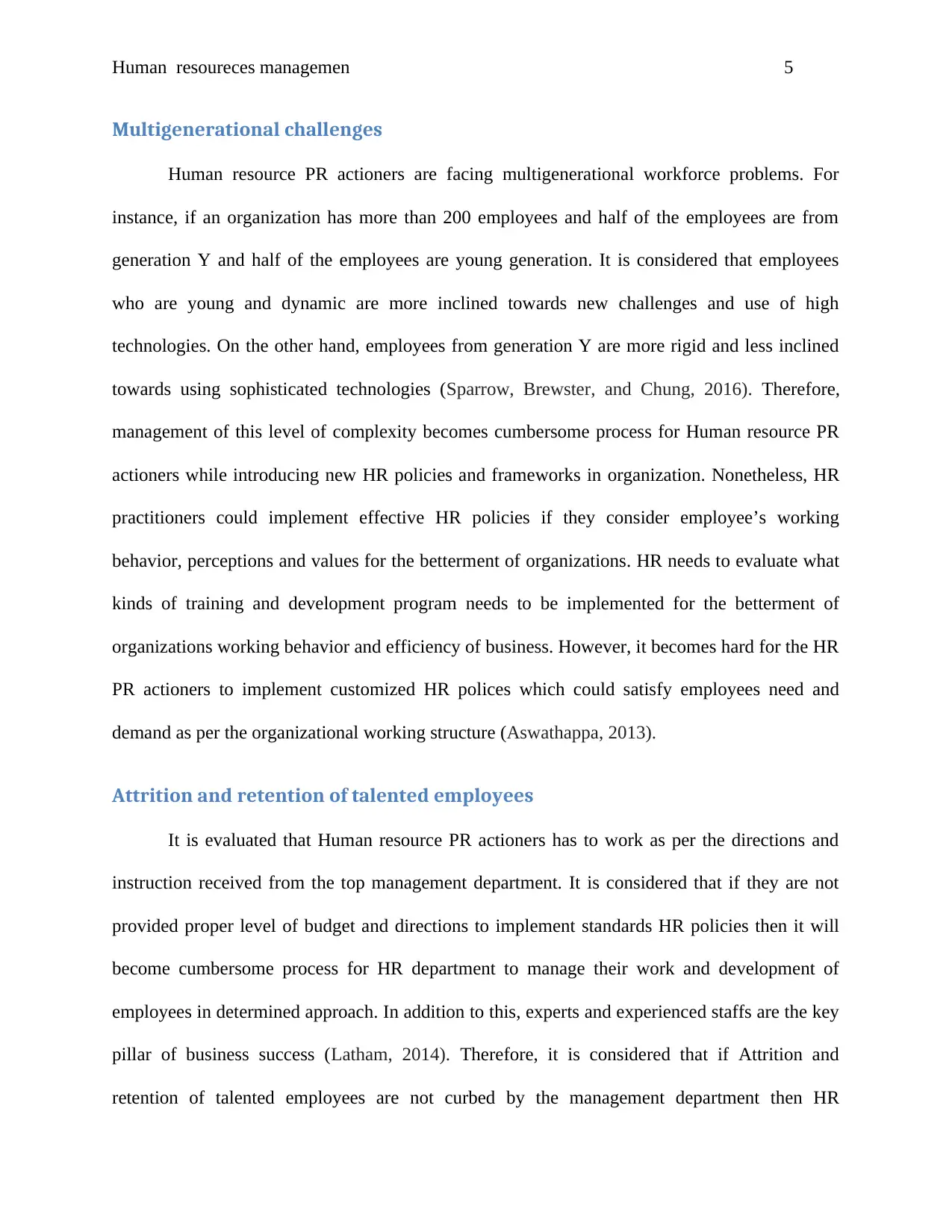
Human resoureces managemen 5
Multigenerational challenges
Human resource PR actioners are facing multigenerational workforce problems. For
instance, if an organization has more than 200 employees and half of the employees are from
generation Y and half of the employees are young generation. It is considered that employees
who are young and dynamic are more inclined towards new challenges and use of high
technologies. On the other hand, employees from generation Y are more rigid and less inclined
towards using sophisticated technologies (Sparrow, Brewster, and Chung, 2016). Therefore,
management of this level of complexity becomes cumbersome process for Human resource PR
actioners while introducing new HR policies and frameworks in organization. Nonetheless, HR
practitioners could implement effective HR policies if they consider employee’s working
behavior, perceptions and values for the betterment of organizations. HR needs to evaluate what
kinds of training and development program needs to be implemented for the betterment of
organizations working behavior and efficiency of business. However, it becomes hard for the HR
PR actioners to implement customized HR polices which could satisfy employees need and
demand as per the organizational working structure (Aswathappa, 2013).
Attrition and retention of talented employees
It is evaluated that Human resource PR actioners has to work as per the directions and
instruction received from the top management department. It is considered that if they are not
provided proper level of budget and directions to implement standards HR policies then it will
become cumbersome process for HR department to manage their work and development of
employees in determined approach. In addition to this, experts and experienced staffs are the key
pillar of business success (Latham, 2014). Therefore, it is considered that if Attrition and
retention of talented employees are not curbed by the management department then HR
Multigenerational challenges
Human resource PR actioners are facing multigenerational workforce problems. For
instance, if an organization has more than 200 employees and half of the employees are from
generation Y and half of the employees are young generation. It is considered that employees
who are young and dynamic are more inclined towards new challenges and use of high
technologies. On the other hand, employees from generation Y are more rigid and less inclined
towards using sophisticated technologies (Sparrow, Brewster, and Chung, 2016). Therefore,
management of this level of complexity becomes cumbersome process for Human resource PR
actioners while introducing new HR policies and frameworks in organization. Nonetheless, HR
practitioners could implement effective HR policies if they consider employee’s working
behavior, perceptions and values for the betterment of organizations. HR needs to evaluate what
kinds of training and development program needs to be implemented for the betterment of
organizations working behavior and efficiency of business. However, it becomes hard for the HR
PR actioners to implement customized HR polices which could satisfy employees need and
demand as per the organizational working structure (Aswathappa, 2013).
Attrition and retention of talented employees
It is evaluated that Human resource PR actioners has to work as per the directions and
instruction received from the top management department. It is considered that if they are not
provided proper level of budget and directions to implement standards HR policies then it will
become cumbersome process for HR department to manage their work and development of
employees in determined approach. In addition to this, experts and experienced staffs are the key
pillar of business success (Latham, 2014). Therefore, it is considered that if Attrition and
retention of talented employees are not curbed by the management department then HR
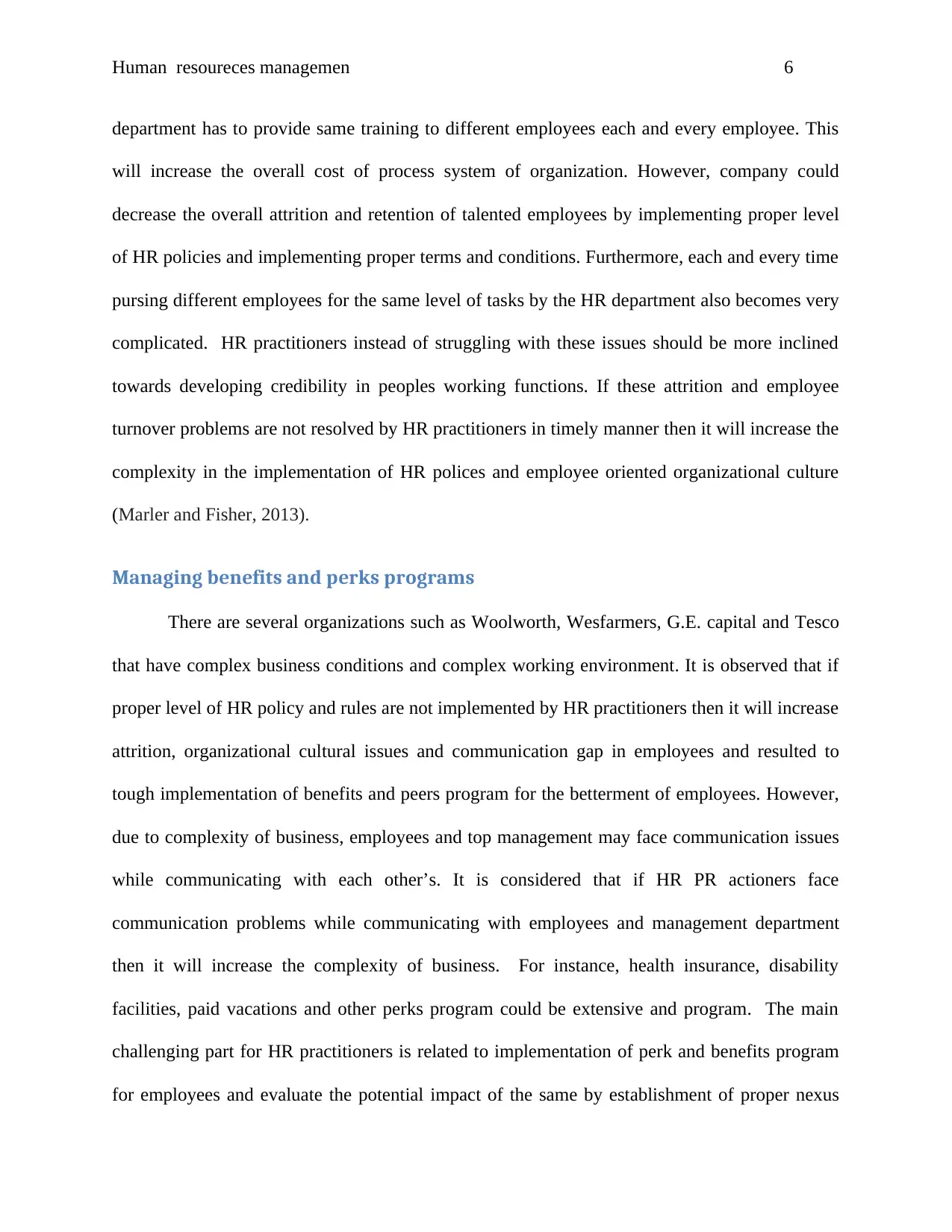
Human resoureces managemen 6
department has to provide same training to different employees each and every employee. This
will increase the overall cost of process system of organization. However, company could
decrease the overall attrition and retention of talented employees by implementing proper level
of HR policies and implementing proper terms and conditions. Furthermore, each and every time
pursing different employees for the same level of tasks by the HR department also becomes very
complicated. HR practitioners instead of struggling with these issues should be more inclined
towards developing credibility in peoples working functions. If these attrition and employee
turnover problems are not resolved by HR practitioners in timely manner then it will increase the
complexity in the implementation of HR polices and employee oriented organizational culture
(Marler and Fisher, 2013).
Managing benefits and perks programs
There are several organizations such as Woolworth, Wesfarmers, G.E. capital and Tesco
that have complex business conditions and complex working environment. It is observed that if
proper level of HR policy and rules are not implemented by HR practitioners then it will increase
attrition, organizational cultural issues and communication gap in employees and resulted to
tough implementation of benefits and peers program for the betterment of employees. However,
due to complexity of business, employees and top management may face communication issues
while communicating with each other’s. It is considered that if HR PR actioners face
communication problems while communicating with employees and management department
then it will increase the complexity of business. For instance, health insurance, disability
facilities, paid vacations and other perks program could be extensive and program. The main
challenging part for HR practitioners is related to implementation of perk and benefits program
for employees and evaluate the potential impact of the same by establishment of proper nexus
department has to provide same training to different employees each and every employee. This
will increase the overall cost of process system of organization. However, company could
decrease the overall attrition and retention of talented employees by implementing proper level
of HR policies and implementing proper terms and conditions. Furthermore, each and every time
pursing different employees for the same level of tasks by the HR department also becomes very
complicated. HR practitioners instead of struggling with these issues should be more inclined
towards developing credibility in peoples working functions. If these attrition and employee
turnover problems are not resolved by HR practitioners in timely manner then it will increase the
complexity in the implementation of HR polices and employee oriented organizational culture
(Marler and Fisher, 2013).
Managing benefits and perks programs
There are several organizations such as Woolworth, Wesfarmers, G.E. capital and Tesco
that have complex business conditions and complex working environment. It is observed that if
proper level of HR policy and rules are not implemented by HR practitioners then it will increase
attrition, organizational cultural issues and communication gap in employees and resulted to
tough implementation of benefits and peers program for the betterment of employees. However,
due to complexity of business, employees and top management may face communication issues
while communicating with each other’s. It is considered that if HR PR actioners face
communication problems while communicating with employees and management department
then it will increase the complexity of business. For instance, health insurance, disability
facilities, paid vacations and other perks program could be extensive and program. The main
challenging part for HR practitioners is related to implementation of perk and benefits program
for employees and evaluate the potential impact of the same by establishment of proper nexus
⊘ This is a preview!⊘
Do you want full access?
Subscribe today to unlock all pages.

Trusted by 1+ million students worldwide
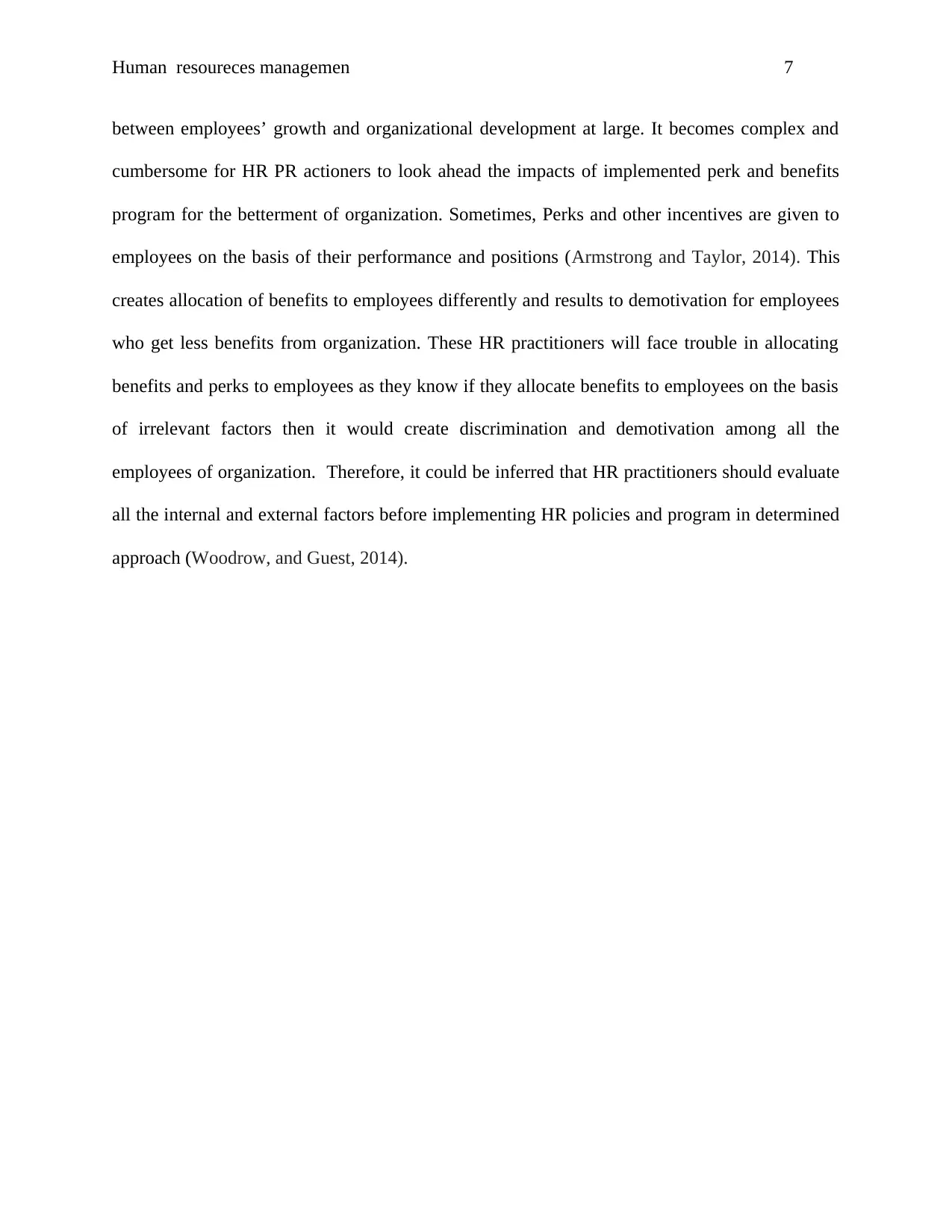
Human resoureces managemen 7
between employees’ growth and organizational development at large. It becomes complex and
cumbersome for HR PR actioners to look ahead the impacts of implemented perk and benefits
program for the betterment of organization. Sometimes, Perks and other incentives are given to
employees on the basis of their performance and positions (Armstrong and Taylor, 2014). This
creates allocation of benefits to employees differently and results to demotivation for employees
who get less benefits from organization. These HR practitioners will face trouble in allocating
benefits and perks to employees as they know if they allocate benefits to employees on the basis
of irrelevant factors then it would create discrimination and demotivation among all the
employees of organization. Therefore, it could be inferred that HR practitioners should evaluate
all the internal and external factors before implementing HR policies and program in determined
approach (Woodrow, and Guest, 2014).
between employees’ growth and organizational development at large. It becomes complex and
cumbersome for HR PR actioners to look ahead the impacts of implemented perk and benefits
program for the betterment of organization. Sometimes, Perks and other incentives are given to
employees on the basis of their performance and positions (Armstrong and Taylor, 2014). This
creates allocation of benefits to employees differently and results to demotivation for employees
who get less benefits from organization. These HR practitioners will face trouble in allocating
benefits and perks to employees as they know if they allocate benefits to employees on the basis
of irrelevant factors then it would create discrimination and demotivation among all the
employees of organization. Therefore, it could be inferred that HR practitioners should evaluate
all the internal and external factors before implementing HR policies and program in determined
approach (Woodrow, and Guest, 2014).
Paraphrase This Document
Need a fresh take? Get an instant paraphrase of this document with our AI Paraphraser
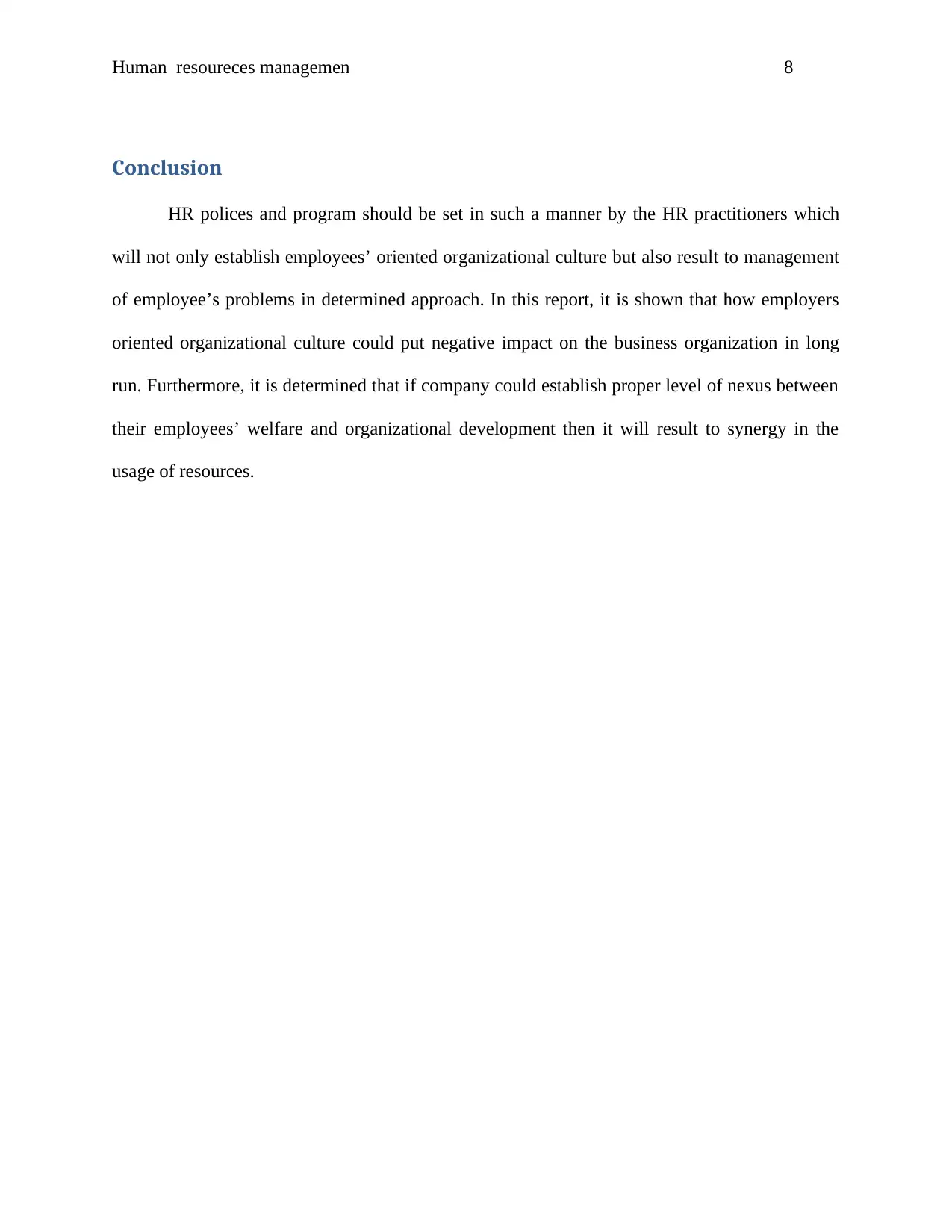
Human resoureces managemen 8
Conclusion
HR polices and program should be set in such a manner by the HR practitioners which
will not only establish employees’ oriented organizational culture but also result to management
of employee’s problems in determined approach. In this report, it is shown that how employers
oriented organizational culture could put negative impact on the business organization in long
run. Furthermore, it is determined that if company could establish proper level of nexus between
their employees’ welfare and organizational development then it will result to synergy in the
usage of resources.
Conclusion
HR polices and program should be set in such a manner by the HR practitioners which
will not only establish employees’ oriented organizational culture but also result to management
of employee’s problems in determined approach. In this report, it is shown that how employers
oriented organizational culture could put negative impact on the business organization in long
run. Furthermore, it is determined that if company could establish proper level of nexus between
their employees’ welfare and organizational development then it will result to synergy in the
usage of resources.
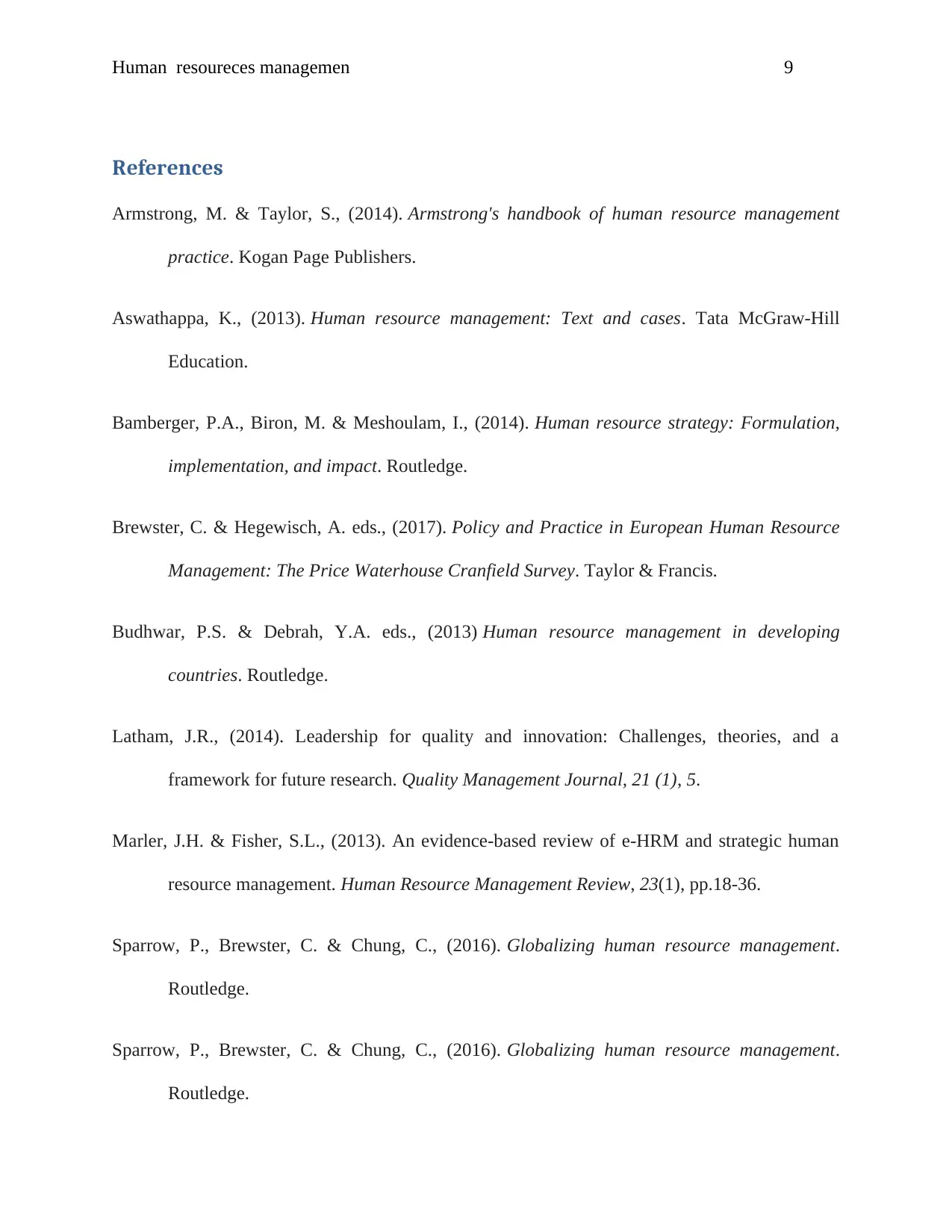
Human resoureces managemen 9
References
Armstrong, M. & Taylor, S., (2014). Armstrong's handbook of human resource management
practice. Kogan Page Publishers.
Aswathappa, K., (2013). Human resource management: Text and cases. Tata McGraw-Hill
Education.
Bamberger, P.A., Biron, M. & Meshoulam, I., (2014). Human resource strategy: Formulation,
implementation, and impact. Routledge.
Brewster, C. & Hegewisch, A. eds., (2017). Policy and Practice in European Human Resource
Management: The Price Waterhouse Cranfield Survey. Taylor & Francis.
Budhwar, P.S. & Debrah, Y.A. eds., (2013) Human resource management in developing
countries. Routledge.
Latham, J.R., (2014). Leadership for quality and innovation: Challenges, theories, and a
framework for future research. Quality Management Journal, 21 (1), 5.
Marler, J.H. & Fisher, S.L., (2013). An evidence-based review of e-HRM and strategic human
resource management. Human Resource Management Review, 23(1), pp.18-36.
Sparrow, P., Brewster, C. & Chung, C., (2016). Globalizing human resource management.
Routledge.
Sparrow, P., Brewster, C. & Chung, C., (2016). Globalizing human resource management.
Routledge.
References
Armstrong, M. & Taylor, S., (2014). Armstrong's handbook of human resource management
practice. Kogan Page Publishers.
Aswathappa, K., (2013). Human resource management: Text and cases. Tata McGraw-Hill
Education.
Bamberger, P.A., Biron, M. & Meshoulam, I., (2014). Human resource strategy: Formulation,
implementation, and impact. Routledge.
Brewster, C. & Hegewisch, A. eds., (2017). Policy and Practice in European Human Resource
Management: The Price Waterhouse Cranfield Survey. Taylor & Francis.
Budhwar, P.S. & Debrah, Y.A. eds., (2013) Human resource management in developing
countries. Routledge.
Latham, J.R., (2014). Leadership for quality and innovation: Challenges, theories, and a
framework for future research. Quality Management Journal, 21 (1), 5.
Marler, J.H. & Fisher, S.L., (2013). An evidence-based review of e-HRM and strategic human
resource management. Human Resource Management Review, 23(1), pp.18-36.
Sparrow, P., Brewster, C. & Chung, C., (2016). Globalizing human resource management.
Routledge.
Sparrow, P., Brewster, C. & Chung, C., (2016). Globalizing human resource management.
Routledge.
⊘ This is a preview!⊘
Do you want full access?
Subscribe today to unlock all pages.

Trusted by 1+ million students worldwide
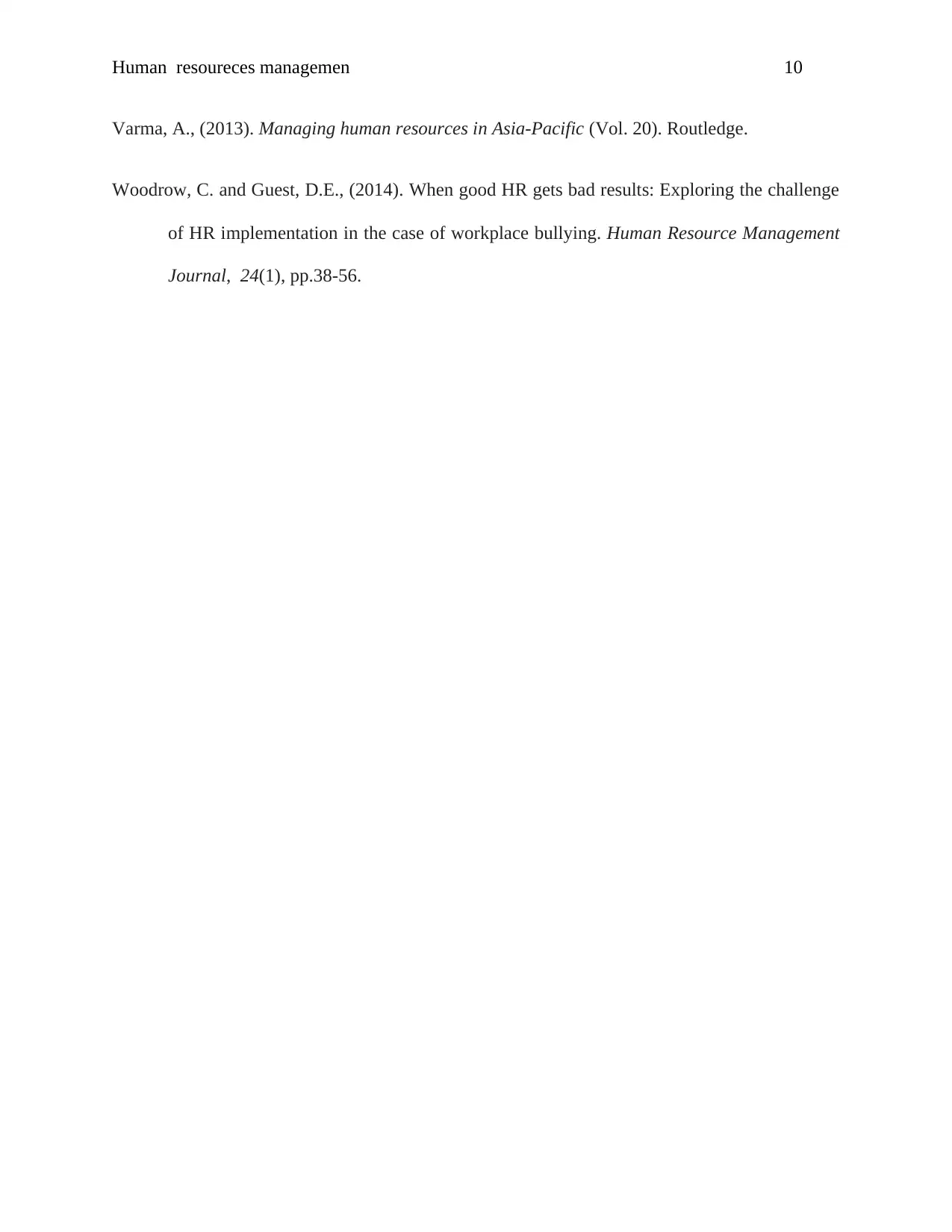
Human resoureces managemen 10
Varma, A., (2013). Managing human resources in Asia-Pacific (Vol. 20). Routledge.
Woodrow, C. and Guest, D.E., (2014). When good HR gets bad results: Exploring the challenge
of HR implementation in the case of workplace bullying. Human Resource Management
Journal, 24(1), pp.38-56.
Varma, A., (2013). Managing human resources in Asia-Pacific (Vol. 20). Routledge.
Woodrow, C. and Guest, D.E., (2014). When good HR gets bad results: Exploring the challenge
of HR implementation in the case of workplace bullying. Human Resource Management
Journal, 24(1), pp.38-56.
1 out of 10
Related Documents
Your All-in-One AI-Powered Toolkit for Academic Success.
+13062052269
info@desklib.com
Available 24*7 on WhatsApp / Email
![[object Object]](/_next/static/media/star-bottom.7253800d.svg)
Unlock your academic potential
Copyright © 2020–2025 A2Z Services. All Rights Reserved. Developed and managed by ZUCOL.




